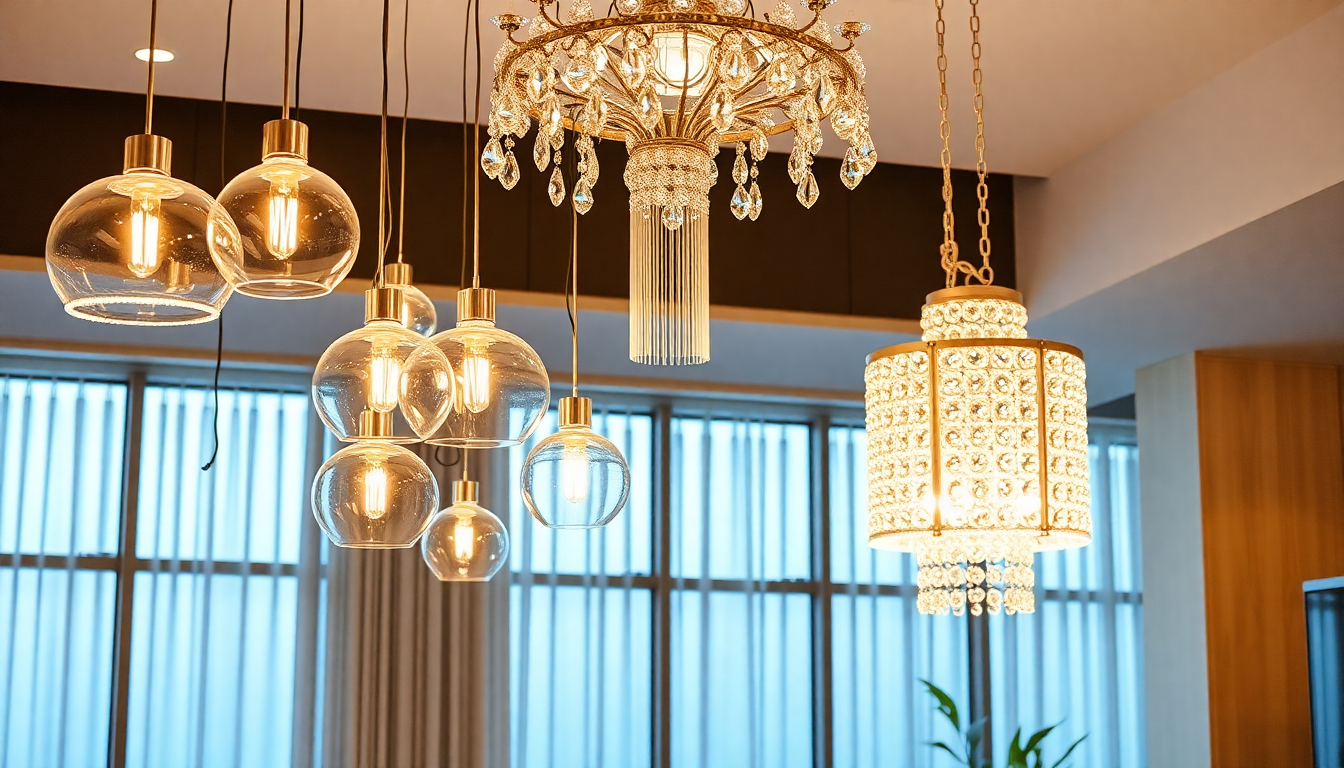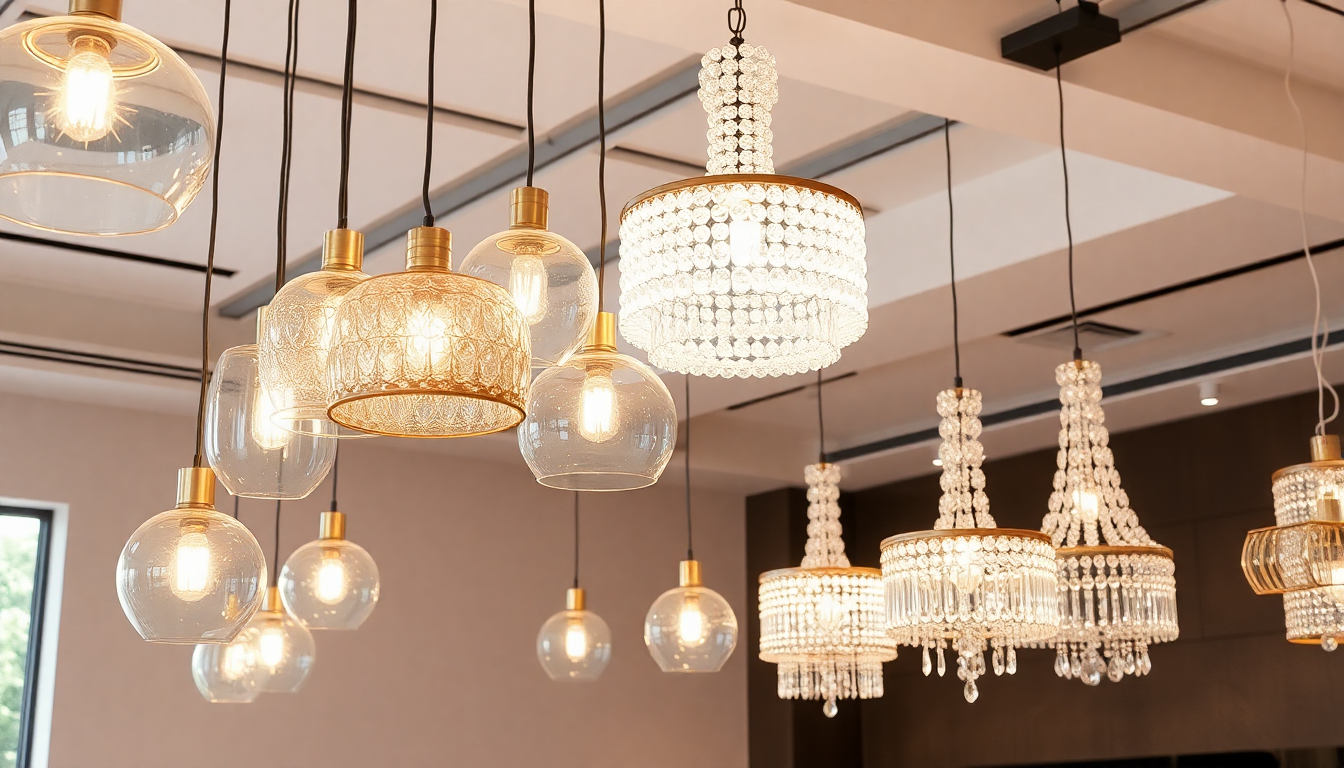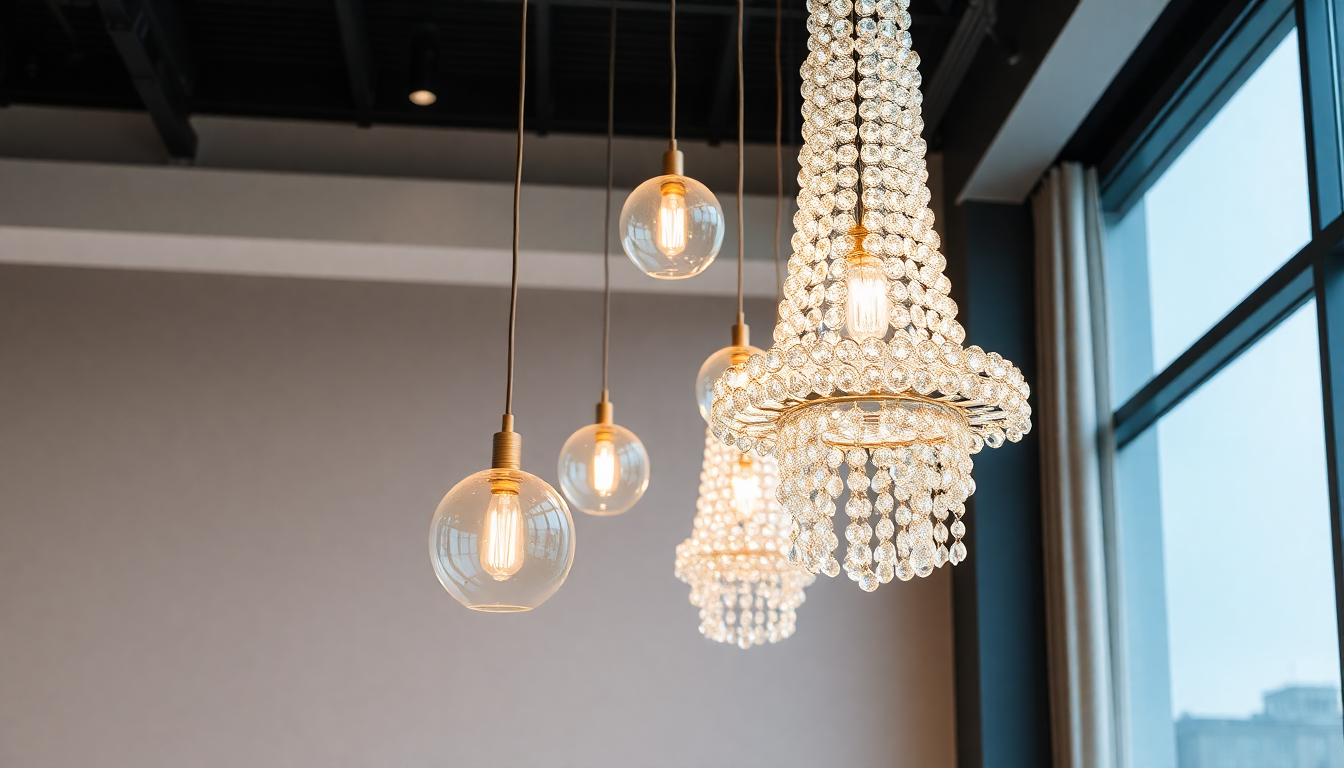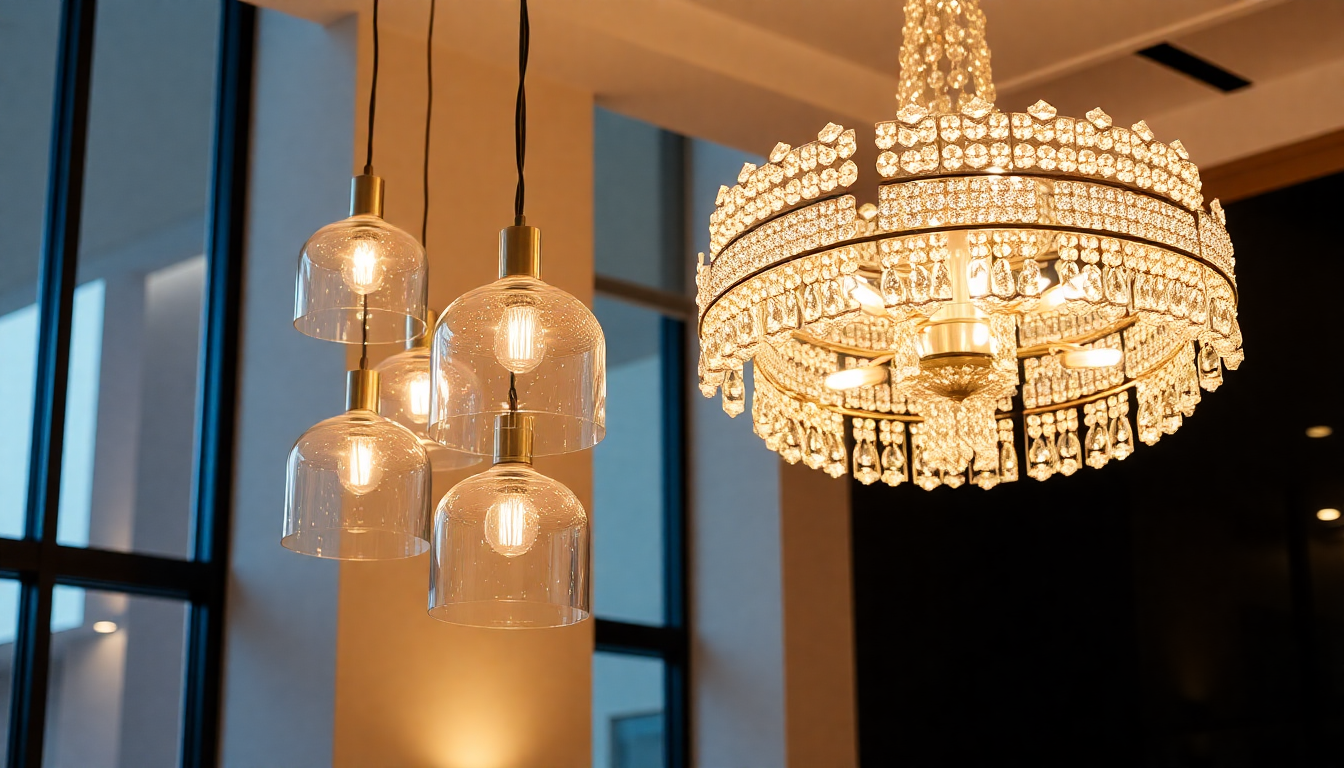Introduction: The Power of Scale and Rhythm in Lighting
Lighting is one of the most effective tools for shaping how a room feels and functions. When glass pendant lights and crystal chandeliers are paired thoughtfully, they create visual flow, emphasize architecture, and define zones. In 2025 the trend continues toward layered lighting that balances artisan materials like blown glass and stained glass with the glamour of crystal. This guide explains how to combine milk glass pendant light, stained glass pendant light, blown glass pendant lights and crystal chandeliers to craft proportion, cadence, and atmosphere.
Key Concepts: Scale, Rhythm, Proportion and Light Quality
- Scale: Match fixture size to the room and to one another so nothing appears lost or overwhelming.
- Rhythm: Use repetition, spacing and variation to create visual beats that guide the eye through the space.
- Proportion: Maintain relationships between fixture dimensions and furniture size for balance.
- Light quality: Glass type affects diffusion, color, and shadow. Milk glass pendant light diffuses softly; stained glass pendant light adds color; blown glass pendant lights produce sculptural pools of light.
Understanding Glass Types and Their Visual Effects
- Milk glass: Soft, opaque, high diffusion. Excellent for warm, cozy atmospheres and for blending with crystal highlights.
- Stained glass: Adds color, pattern and handcrafted charm. Use as accent punctuation or to create color transitions between zones.
- Blown glass: Organic shapes and varying thickness create interesting light patterns and reflections. Great for sculptural clusters.
- Clear and frosted glass: Clear glass maximizes sparkle and reflections; frosted glass reduces glare and increases ambient softness.
How to Choose the Perfect Chandelier and Complementary Pendants
Start with the chandelier as an anchor, then select pendant lights that support its scale and style. Follow this process:
- Measure the room and determine ceiling height and focal areas.
- Pick the chandelier that suits the room size and mood.
- Choose pendants that are 30 to 60 percent of the chandelier tier diameter for a balanced relationship, adjusting based on visual weight and form.
- Decide on glass types: milk glass to soften, stained glass to add color, blown glass to add form.
- Test spacing and heights with paper templates or mockups before final installation.
Common Sizing Rules and Placement Guidelines
- Chandelier diameter rule: Sum room length and width in feet, then use that sum in inches as an approximate chandelier diameter. For example, a 12 by 14 ft room -> 12 + 14 = 26, target chandelier ~26 inches in diameter.
- Height above dining table: 30 to 36 inches from table surface to the bottom of the chandelier or pendant cluster for ceilings 8 to 9 feet. Increase height by 3 inches per additional foot of ceiling height.
- Distance between multiple pendants: space pendants 24 to 30 inches on center for standard islands, adjusting for pendant diameter and island length.
- General room proportion: chandelier should not extend beyond 1/3 of table width in small dining rooms and should visually anchor seating arrangements in living spaces.
Creating Visual Flow: Rhythm Techniques
- Repetition: Use multiple pendants in the same form and finish to create steady rhythm leading to the chandelier.
- Alternation: Alternate colors or glass types, for example blown glass pendants interspersed with milk glass pendant light, for a syncopated look.
- Graduation: Gradually change pendant sizes or heights to draw the eye toward the chandelier.
- Anchoring: Let the chandelier be the visual terminus. Pendants should direct attention rather than compete with it.
Room-by-Room Guidance: Kitchens, Dining, Living, Entry, Bedroom & Bathroom
Kitchens and Islands
- Use a linear run of 2 to 5 pendants depending on island length. Blown glass pendant lights work beautifully to create sculptural rhythm.
- Place pendants 30 to 36 inches above the countertop. For kitchen islands paired visually with a nearby chandelier in a dining area, keep pendant finishes cohesive with the chandelier finish.
- For a modern look, choose clear or frosted blown glass for crisp reflections. For warmth, use milk glass pendant light.
Dining Rooms
- Anchor the dining table with a chandelier sized using the room rule. Add a pair of milk glass or stained glass pendant light on either side for layered drama in large rooms or open plan spaces.
- If the chandelier sits in a nearby living area, use a linear row of blown glass pendants over the table to create a directional flow between zones.
Open Plan Living
- Establish sequence by using pendants to define transitional paths between kitchen, dining and living. Use a chandelier as the main focal point in the living area and pendants as wayfinding elements.
- Maintain a consistent ceiling canopy finish and unified bulb temperature to knit spaces together.
Entryways and Foyers
- Stained glass pendant light makes an excellent greeting piece that introduces color and materiality before a crystal chandelier in the main space.
- Layer height to create drama: a higher-hung stained glass pendant in the foyer can echo chandelier tiers visible through an upstairs opening.
Bedrooms
- Use milk glass pendant light as bedside lighting to free up nightstand space while keeping lighting soft and flattering.
- A small crystal chandelier or mini chandelier can anchor the room without overpowering. Pair with blown glass pendants for textural contrast.
Bathrooms and Powder Rooms
- Small chandeliers with crystal accents and a pair of milk or frosted glass pendants flanking mirrors add glam while providing practical task light.
- Ensure fixtures are rated for damp locations and select LED bulbs with high CRI for accurate color rendering.
Bulbs, Color Temperature and CRI: Getting the Light Right
- Choose LED bulbs for efficiency and long life. Aim for 2700K to 3000K for warm, inviting light in living spaces and 3000K to 3500K for task-oriented areas like kitchens.
- Prioritize CRI 90+ when showing true colors matters, for example with stained glass pendant light accents or in dining and kitchen spaces.
- Use dimmable LEDs and compatible dimmers to control mood and balance the interaction between pendants and chandeliers.
Dimmers and Controls
Layered lighting works best with zoning controls. Use the chandelier on one circuit and pendant groups on separate circuits so you can create different scenes. Smart lighting allows presets, color temperature tuning and integration with voice assistants for hands-free control.
Mixing Metals, Finishes and Materials
Unify the composition by repeating a finish across fixtures, or intentionally mix finishes for contrast. If a crystal chandelier has polished chrome arms, echo chrome accents on pendant hardware. For warmer, vintage looks pair milk glass pendant light with brushed brass chandelier details. Stained glass often pairs best with darker patinas that ground the color.
Design Case Studies: Practical Examples
Case Study 1: Urban Open Plan Apartment
Situation: 800 sq ft open plan with kitchen island and adjacent living area. Solution: Install three blown glass pendant lights over the island at 34 inches above counter, spaced 28 inches on center, finished in matte black hardware. In the living area, a medium crystal chandelier 26 inches in diameter anchors the seating. The blown glass forms create a path from kitchen to living while the chandelier provides a formal resting point.
Case Study 2: Historic Home Entry to Modern Living Room
Situation: Tall foyer with stained glass window and lower-ceiling living room. Solution: A stained glass pendant light in the foyer introduces color and craftsman charm. In the living room, a multi-tier crystal chandelier mirrors ceiling height and adds sparkle. A pair of milk glass pendant light flank the fireplace to create continuity of material while toning down the crystal.
Case Study 3: Minimalist Dining with Statement Pendants
Situation: Minimal palette, long dining table, adjacent seating area with small chandelier. Solution: Three identical milk glass pendant light hung low in a linear run above the table create calm, even illumination. A small crystal chandelier in the seating area introduces a contrasting texture that becomes a subtle focal point without overpowering the minimal aesthetic.
Installation and Safety Tips
- Always turn off power at the breaker before installing fixtures. If you are unsure, hire a licensed electrician.
- Ensure ceiling boxes are rated for the weight of chandeliers. Heavy crystal fixtures often require reinforced mounting brackets.
- Wire pendant groups to independent circuits when possible so you can control each zone separately.
- Use correct canopy sizes and conceal wiring neatly for a clean finish.
Care and Maintenance for Glass and Crystal
- Dust regularly with a soft microfiber cloth. For crystal, use distilled water with a tiny bit of dish soap and pat dry to avoid water spots.
- Avoid ammonia-based cleaners on stained glass and some antique glass finishes. Use a gentle glass cleaner or mild soap and water.
- For blown glass pendants, remove shades periodically to clean inside and out to maintain light quality and color purity.
- Inspect suspension cables and mounting hardware annually for wear, especially for larger crystal chandeliers.
Budget Strategies: Luxury Look Without Large Spend
- Choose one high-impact chandelier and complement it with more affordable glass pendant lights to create the appearance of a curated collection.
- Consider swapping out shades on inexpensive pendant bases for hand-blown or milk glass shades to elevate the overall look.
- Refurbish vintage fixtures: clean crystal drops, rewire safely, and pair with new LED bulbs for an instant upscale update.
Mixing and Matching: Rules for a Cohesive Composition
- Unify at least one element across fixtures: metal finish, bulb temperature, or glass tone.
- Limit the number of distinct glass types in a single visual plane to three to keep the look intentional.
- Use scale as your hierarchy tool: larger fixtures anchor, smaller pendants support.
Inspiration Gallery and Product Links
Below are curated product links and images to help you start building the layered lighting scheme described above. These examples illustrate glass pendant lighting across milk, stained and blown varieties, and coordinating crystal chandeliers.
-
Glass pendant lighting collection — curated selection of milk, stained and blown glass pendant lights.
-
Milk glass pendant light — soft, diffused glow ideal for bedside and kitchen use.
-
Stained glass pendant light — handcrafted color and pattern for entry and accent zones.
-
Blown glass pendant lights — organic forms and artisan textures for islands and clusters.
-
Crystal chandeliers collection — tiered and modern crystal chandeliers to anchor living and dining spaces.
Trends and Styles to Watch in 2025
- Hybrid finishes: designers are mixing matte metals with crystal to modernize classic looks.
- Artisanal glass: demand for blown glass pendant lights with unique irregularities continues to rise.
- Color-forward fixtures: stained glass pendant light and colored blown glass add personality to neutral interiors.
- Smart layering: integrated controls and tunable white LEDs let you shift scenes between bright task light and warm ambient glow.
Step-by-Step Design Checklist
- Define the anchor zone and select a chandelier that matches room scale.
- Choose the type of glass for pendants based on light quality and aesthetic: milk glass for softness, stained glass for color, blown glass for form.
- Calculate pendant spacing and height; create mockups using templates to visualize rhythm.
- Pick bulbs with the right color temperature and CRI; plan dimmer placement and smart controls.
- Install with attention to weight and wiring safety; use a professional for heavy or complex installs.
- Maintain fixtures regularly to keep glass and crystal sparkling and crystal facets refracting beautifully.
Final Thoughts: Designing with Intention
Pairing glass pendant lights and crystal chandeliers is an opportunity to compose a room in light. By considering scale, rhythm, glass type and finish, you can orchestrate visual flow that feels intentional and layered. Whether you choose milk glass pendant light for calm diffusion, stained glass pendant light for vibrant accents, or blown glass pendant lights for sculptural interest, combine them with a crystal chandelier to create focal depth and atmospheric richness. Start small, test arrangements, and iterate until the rhythm feels natural.
Further Reading and Related Guides
- How to Choose the Perfect Chandelier for Your Space
- Luxury Lighting on a Budget: Affordable Glass Chandeliers That Look Expensive
- The Best Modern Glass Pendant Lighting Ideas for Kitchens & Dining Areas
- Clear vs Frosted Glass Pendants: Which One is Right for You?
- How to Style Glass Pendant Lights in Minimalist and Contemporary Interiors
- Mixing and Matching Glass Pendants: A Guide to Creating a Unique Look
- Statement Glass Pendants: How to Make Your Lighting the Focal Point
Ready to Start Designing?
Explore our collections and product pages to find glass pendant lights, milk glass pendant light options, stained glass pendant light designs, blown glass pendant lights, and crystal chandeliers that work together to create beautiful visual flow in your home. If you need help planning the layout or choosing fixtures, contact our design team for a personalized consultation.
Keywords used in this article for SEO: glass pendant lights, glass pendant lighting, milk glass pendant light, stained glass pendant light, blown glass pendant lights, crystal chandeliers.




